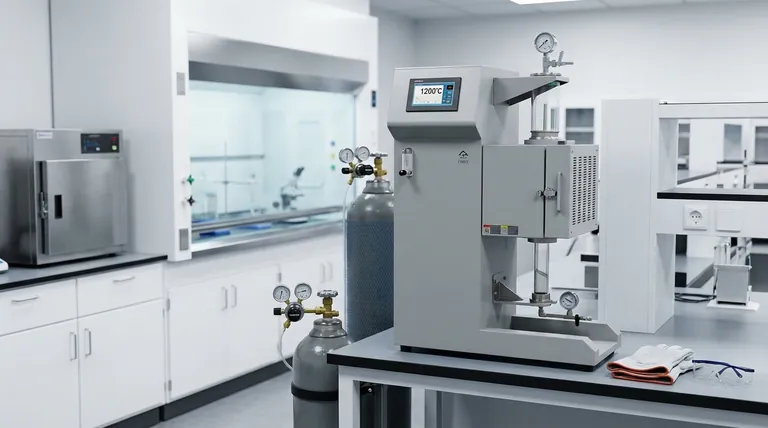At its core, a heat treatment furnace must provide precise control over temperature and the internal atmosphere. Its fundamental requirements include a well-sealed furnace body, a regulated heat source (either electric or gas-fuelled), mechanisms for atmosphere control, and integrated systems for handling and cooling the material being treated.
A heat treatment furnace is not merely an oven; it is a highly controlled environment engineered to modify a material's metallurgical properties through the precise application of thermal energy and management of its chemical environment.

The Foundational Requirement: Precision Temperature Control
The most basic function of any furnace is to generate and maintain heat. In heat treatment, how this is accomplished is critical to the final outcome.
The Heat Source
The heart of the furnace is its heating system. This is typically achieved through electric resistance elements or gas-fuelled burners, each offering different operational characteristics.
Dynamic Heat Regulation
Heat application is not static. A furnace control system must deliver a high amount of energy to reach the target temperature quickly and then reduce output to precisely maintain that temperature for the required duration.
Superior Insulation
Effective heat treatment requires uniformity and stability. The furnace body must be exceptionally well-insulated to prevent heat loss, ensuring both energy efficiency and consistent internal temperatures. A well-designed furnace top, for example, should generally not exceed 300°C.
The Critical Element: Atmosphere Control
For many advanced heat treatment processes, controlling the chemical environment inside the furnace is just as important as controlling the temperature. This prevents undesirable reactions like oxidation on the material's surface.
The Sealed Furnace Body
The first requirement for atmosphere control is an airtight furnace chamber. A well-sealed body prevents oxygen from the outside air from entering and compromising the controlled atmosphere within.
Active Gas Management
Simply sealing the furnace is not enough. A controllable atmosphere furnace requires a ventilation and exhaust device, often using a water-cooled, sealed fan, to introduce specific gases (like nitrogen or endothermic gas) and safely vent byproducts.
Facilitating the Process: Material Handling and Safety
An industrial furnace must function as part of a larger production workflow. This involves moving materials in, through, and out of the extreme environment safely and efficiently.
Loading and Unloading Mechanisms
To handle high temperatures and heavy loads, furnaces rely on mechanical feeding and discharging devices. These systems ensure materials are placed correctly for uniform heating and removed promptly.
Integrated Quenching and Cooling
The cooling phase is a critical part of the heat treatment cycle. Many furnaces, such as retort furnaces, integrate a fast cooling chamber or quenching tank directly, allowing the material to be cooled at a specific, rapid rate without exposure to outside air.
Essential Safety Systems
Working with high heat, combustible gases, and automated machinery presents inherent risks. Therefore, safety and explosion-proof devices are non-negotiable requirements to protect both operators and the equipment.
Understanding the Trade-offs
Selecting or designing a heat treatment furnace involves balancing capability with complexity and cost. There is no single "best" configuration; the right choice depends entirely on the application.
Simplicity vs. Process Control
A simple, air-atmosphere furnace is easier and cheaper to operate but offers no protection against surface oxidation. A controllable atmosphere furnace provides superior metallurgical results but requires more significant investment and operational expertise.
Batch vs. Continuous Operation
Furnaces designed for batch processing are flexible for various parts and cycles. Continuous furnaces are optimized for high-volume production of similar parts but are less flexible and represent a much larger capital investment.
Making the Right Choice for Your Goal
The necessary requirements for a heat treatment furnace are dictated by the desired outcome for the material.
- If your primary focus is simple stress relieving or tempering: A basic furnace with accurate temperature control and good insulation is sufficient.
- If your primary focus is preventing surface scaling and decarburization (e.g., for carburizing or bright hardening): A well-sealed furnace with robust atmosphere control systems is an absolute requirement.
- If your primary focus is achieving specific hardness through rapid cooling: An integrated quenching system, whether oil, water, or gas-based, is non-negotiable.
Ultimately, defining the specific metallurgical properties you need to achieve will determine the necessary complexity and features of your heat treatment furnace.
Summary Table:
| Requirement | Key Components/Functions |
|---|---|
| Precision Temperature Control | Heat source (electric/gas), dynamic regulation, superior insulation |
| Atmosphere Control | Airtight sealed body, active gas management & ventilation |
| Material Handling & Safety | Mechanical loading/unloading, integrated quenching, safety devices |
| Process Type | Batch (flexible) vs. Continuous (high-volume) operation |
Need a furnace that meets your specific heat treatment goals? KINTEK specializes in lab equipment and consumables, providing solutions for precise temperature and atmosphere control. Whether you require simple stress relieving or advanced bright hardening, our expertise ensures your laboratory achieves superior metallurgical results. Contact our experts today to discuss your application!
Visual Guide

Related Products
- Vertical Laboratory Quartz Tube Furnace Tubular Furnace
- Laboratory Muffle Oven Furnace Bottom Lifting Muffle Furnace
- 1400℃ Laboratory Quartz Tube Furnace with Alumina Tube Tubular Furnace
- 1800℃ Muffle Oven Furnace for Laboratory
- Vacuum Heat Treat Furnace and Levitation Induction Melting Furnace
People Also Ask
- What is the standard thickness of plating? Optimize Durability, Corrosion & Cost
- Why does heating increase temperature? Understanding the Molecular Dance of Energy Transfer
- How do you clean a tubular furnace tube? A Step-by-Step Guide to Safe and Effective Maintenance
- What is the difference between upflow and horizontal furnace? Find the Perfect Fit for Your Home's Layout
- What is a vertical tube furnace? Leverage Gravity for Superior Uniformity and Process Control



















